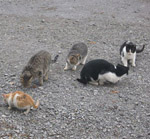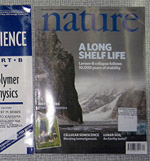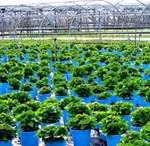Conserving whales by collecting blow samples in the wild
 The blowhole of a grey whale, NOAA photo.New research on pathogens in whales and dolphins illustrates the incredible ingenuity that some scientists display in gathering data on species at risk.
The blowhole of a grey whale, NOAA photo.New research on pathogens in whales and dolphins illustrates the incredible ingenuity that some scientists display in gathering data on species at risk.
Karina Acevedo-Whitehouse and fellow researchers gained fame about a year ago for their work collecting exhaled breath condensate (i.e blow) from whales and dolphins in the Gulf of California and along the Pacific Coast of Baja, Mexico.
They developed two methods for collecting samples. One involved affixing sterile Petri dishes to a foam board at the end of an extendable 3-meter pole, which they would hold from their boat over the blow-hole of nearby individuals.
For cetaceans that kept a greater distance from the boat, they would fly a radio-controlled 3 kg model helicopter over the blow-hole and collect samples with Petri dishes attached by cable to the landing gear.
Now the scientists have published their research in the journal Animal Conservation and their findings expand our very limited understanding of pathogens in cetaceans. This information will help us deal with potentially fatal diseases that can diminish populations of whale and dolphin species, many of which already face serious risk of extinction. Whale sampling, model helicopter in action. Image credit, The Zoological Society of LondonThe researchers collected 22 blow samples from eight cetacean species - common dolphin (Delphinus sp), bottlenose dolphin (Tursiops truncates), Bryde’s whale (Balaenoptera edeni), fin whale (Balaenoptera physalus), sperm whale (Physeter macrocephalus), humpback whale (Megaptera novaeangliae), blue whale (Balaenoptera musculus) and gray whale (Eschrichtius robustus).
Whale sampling, model helicopter in action. Image credit, The Zoological Society of LondonThe researchers collected 22 blow samples from eight cetacean species - common dolphin (Delphinus sp), bottlenose dolphin (Tursiops truncates), Bryde’s whale (Balaenoptera edeni), fin whale (Balaenoptera physalus), sperm whale (Physeter macrocephalus), humpback whale (Megaptera novaeangliae), blue whale (Balaenoptera musculus) and gray whale (Eschrichtius robustus).
Of the pathogens that they screened for, the most commonly detected was Haemophilus, a genus of bacteria that can lead to meningitis, pneumonia and bacteremia during periods of immunosuppression, especially in young animals. Perhaps the biggest contribution of their study, though, has been the development of the innovative sampling methodology. The authors write,
"It is possible that we may be at the start of a new and promising stage in free-ranging cetacean health studies that will provide key data for cetacean conservation. For instance, at the time of writing this paper, it was brought to our attention that blow-sampling attempts to study respiratory microorganisms in resident killer whales from Puget Sound are already underway, and we are certain that similar studies will soon expand across the globe."
--Reviewed by Rob Goldstein
Acevedo-Whitehouse, K., Rocha-Gosselin, A., & Gendron, D. (2009). A novel non-invasive tool for disease surveillance of free-ranging whales and its relevance to conservation programs Animal Conservation DOI: 10.1111/j.1469-1795.2009.00326.x




 Mammals
Mammals
Reader Comments